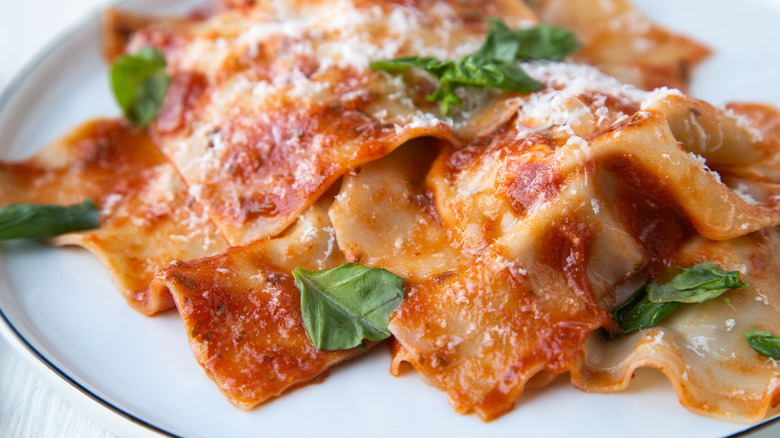The Ingredient Swap That Will Make Homemade Ravioli Easier Than Ever
Homemade ravioli has a wonderfully homey feel, but when stuffed pasta was first conceived in the 16th century, it was as a food fit for kings and other members of the wealthy class, according to food historian Oretta Zaninin De Vita, as quoted by The Culture Trip. That, of course, makes perfect sense when you consider how much work would have to go into hand-constructing each individual ravioli. Not only are you mixing, rolling, and then cutting your homemade pasta dough into bite-sized squares or circles, but you're also pairing them off and using them to construct tiny pillows filled with meats, cheeses and/or vegetables, and sealing them pristinely enough so that their contents won't leak out during cooking.
In time, ravioli came to be embraced by regular folks, first as festive fare, and later, as a time-consuming meal that homemakers may nevertheless have had latitude to undertake, according to The New York Times. In the 20th century, commercially prepared sauces and readily available ground meats streamlined the process. However, that still left the arduous task of making and working with homemade pasta.
Fortunately, Tasting Table recipe developer Kate Shungu came up with an innovative solution that finally closes that loop, effectively making homemade ravioli easy for anyone to make. Shungu's Shortcut Homemade Ravioli Recipe makes use of an ingredient swap that borrows seamlessly from the cuisine of another culture. It's a wonderful example of how our increasingly globalized food culture adds practical value in addition to great taste.
The secret to easy ravioli is in this unexpected Asian ingredient
Tasting Table recipe developer Kate Shungu's innovative recipe for Shortcut Homemade Ravioli "uses wonton wrappers instead of making your own pasta dough," as Shungu explains to Tasting Table. That makes it "easier and faster to make homemade ravioli," she adds. Indeed, swapping in pre-made wonton wrappers for homemade pasta dough makes so much sense that, frankly, we're a little envious that we didn't come up with it on our own. In Italy, after all, wontons are known as "Chinese ravioli," according to South China Morning Post. And check this out for poetic symmetry: In Hong Kong, ravioli is sometimes called "Italian wonton."
You might not appreciate how easy it is to use wonton wrappers for making homemade ravioli until you check out this video in which we see Shungu making the quickest work of ravioli we've ever seen. But while Shungu's hands fly with the sort of ease associated with celebrity chefs, it shouldn't take the average home cook more than 10 to 12 or so minutes to turn 50 wonton-wrappers into 25 raviolis using Shungu's method, which incorporates brushed beaten egg to form a reliable seal on the pasta pockets. It also involves assembling and cooking the raviolis in small sets of seven to eight at a time, which we realized immediately can make things much easier.
"I love how impressive (yet easy) it is to make ravioli at home," Shungu tells us. Well, now we can finally agree!

